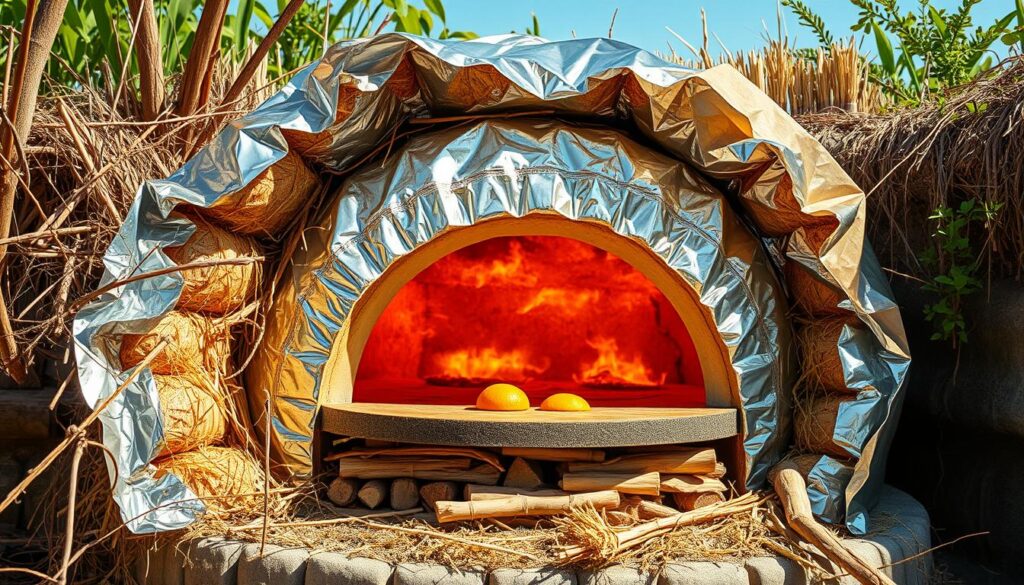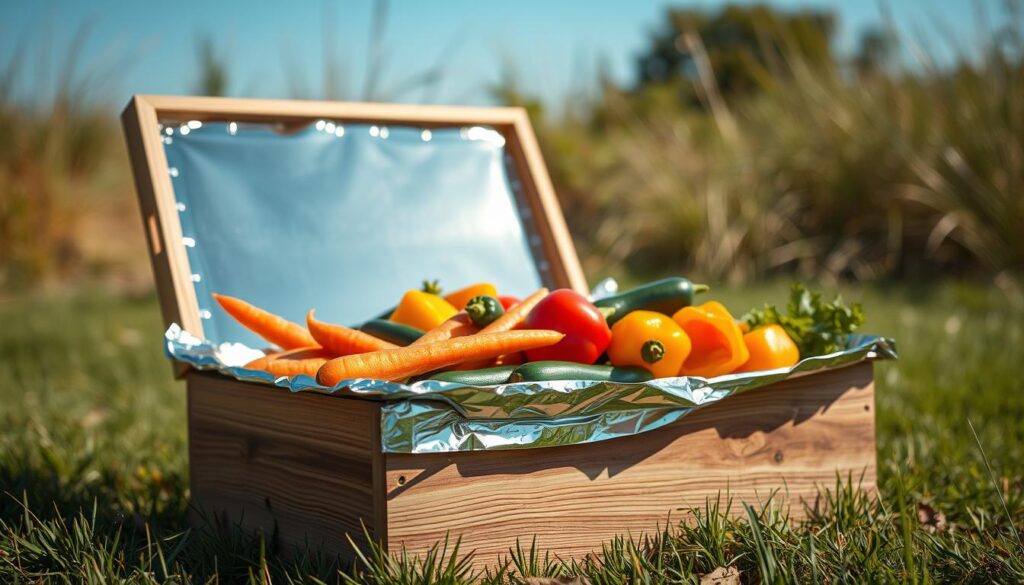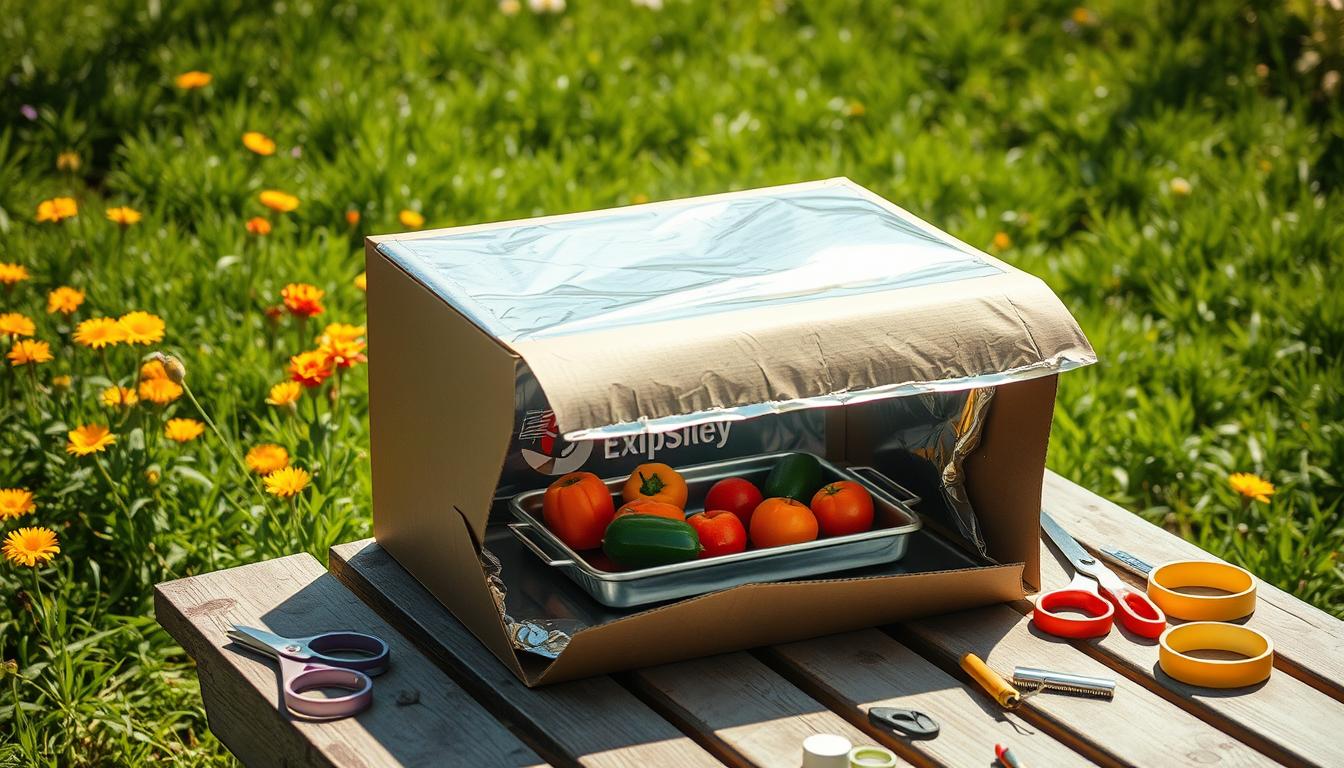Ever thought about cooking with just the sun’s rays? It’s not just a dream – it’s a solar powered oven! I’ll show you how to make one that uses the sun’s energy for cooking. This eco-friendly DIY project is simple and helps reduce your carbon footprint. Plus, you get to enjoy tasty, slow-cooked meals.
Imagine a sunny day with the smell of a stew in the air, all without using electricity. That’s what a solar oven does. These clever devices can get up to 200°F on bright days. They use sunlight to heat air inside, cooking your food perfectly. And the best part? Your solar oven will cook for free as long as the sun is out!
Key Takeaways
- Solar ovens can reach temperatures of 200°F on sunny days
- They use sunlight and reflective materials to heat trapped air
- Black surfaces absorb heat while insulation keeps it inside
- Solar cooking is eco-friendly and has no energy costs
- DIY solar ovens are easy to make and use abundant solar energy
Introduction to Solar Powered Ovens
I’ve always been drawn to eco-friendly cooking methods. Solar powered ovens are a top example of using renewable energy to cook. Let’s explore these smart solar cooking boxes and see how they’re changing cooking.
What is a Solar Powered Oven?
A solar powered oven uses the sun’s energy to cook food. It’s a box that traps heat from sunlight, making it a portable kitchen. These ovens are great for outdoor lovers or anyone wanting to cut down on carbon emissions.
Benefits of Cooking with Solar Energy
Cooking with solar energy is a big change. It’s not just good for the planet; it’s a new way to cook. Here are some benefits:
- Zero fuel costs – the sun’s energy is free!
- No harmful emissions – it’s as clean as cooking gets
- Portable – perfect for camping or off-grid living
- Safe to use – no risk of fire or burns
How Solar Ovens Work: The Science Behind It
The science of solar ovens is fascinating. They use conduction, radiation, and convection. Sunlight enters at an angle, reflected by shiny surfaces inside. The trapped air heats up, while dark-colored materials absorb and retain heat.
Insulation keeps the warmth inside. This turns your solar cooking box into a mini sun-powered kitchen.
“Solar ovens are like capturing a piece of the sun’s power in a box. It’s amazing how something so simple can cook a delicious meal!”
With solar ovens, I’m cooking up a storm using nothing but sunshine. It’s the best of renewable energy cooking, and I’m loving it. Saving the planet has never tasted so good!
Gather Your Materials: What You’ll Need
I’m excited to start our solar cooker project! Before we begin, let’s gather the basics. It’s like a fun treasure hunt for eco-friendly cooking!

First, we need two cardboard boxes. Imagine a Russian doll setup, where one box fits inside the other. We’ll also need extra cardboard for the lid. If you want something more durable, wood is a great option.
Next, we’ll use shiny materials. Aluminum foil helps reflect sunlight, while black paper absorbs heat. This combo is like cooking with the sun!
Now, let’s talk about the glue and tape. We’ll use these to hold our solar oven together. We also need clear plastic wrap or Plexiglas to keep the heat in.
Here’s a quick checklist of what you’ll need:
| Essential Items | Optional Upgrades |
|---|---|
| Two cardboard boxes | Wooden boxes |
| Loose cardboard for lid | Glass lid |
| Aluminum foil | Reflective mylar |
| Black paper | Black paint |
| Glue and duct tape | High-temp silicone adhesive |
| Plastic wrap or Plexiglas | Tempered glass |
| Newspaper for insulation | Fiberglass insulation |
| Scissors or box cutter | Electric saw |
| Wire hanger or stick | Adjustable prop rod |
With these materials ready, we’re ready to start our solar cooker project. Let’s use the sun’s power to make tasty, eco-friendly meals!
How to Make a Solar Powered Oven: Step-by-Step Guide
Ready to start your solar oven DIY project? I’ve got a simple guide for you. Let’s make an eco-friendly cooking wonder together!
Prepare the Boxes
First, grab two cardboard boxes. One should be slightly smaller than the other. These will be the base of your solar oven. Cut the flaps off the larger box, but keep them for later use.
Create the Insulation Chamber
Place the smaller box inside the larger one. Fill the gap with crumpled newspaper. This creates an insulation chamber, trapping heat and boosting efficiency.
Construct the Lid
Remember the flaps we saved? Now it’s time to use them! Attach three flaps to one side of the larger box. Leave one flap open as a “door” for easy access.
Line with Reflective Material
Now, the magic happens! Line the inside of both boxes and the lid with aluminum foil, shiny side out. This reflects sunlight, turning your oven into a heat-trapping marvel.
Add Insulation
For the final touch, cover the bottom of the inner box with black construction paper. This absorbs heat, making your oven more effective. Finish with a double layer of plastic wrap or plexiglass over the opening to seal in the heat.
Voila! You’ve just made a solar powered oven. Now, you’re ready to use the sun’s power to cook tasty, eco-friendly meals!
The Importance of Proper Insulation

Insulation is a key part of solar ovens. It keeps the heat in, like a blanket for your food. Make sure to include it when you build your oven.
I use crumpled newspaper for insulation. I put it between the boxes to trap heat. This makes my oven very efficient for eco-friendly cooking.
“Good insulation is the secret sauce that turns a box into a solar oven.”
Here’s why insulation is important:
- Maintains consistent cooking temperatures
- Reduces cooking time
- Maximizes energy efficiency
- Allows cooking even in less-than-ideal weather
Insulation has turned my solar oven into a reliable cooking tool. A few sheets of newspaper can greatly improve heat trapping and cooking.
The aim is to make your oven like a mini-greenhouse. With good insulation, you’ll cook delicious meals using the sun. It’s a fun and effective way to cook.
Maximizing Solar Energy Absorption
I’ve found that a great solar cooking box needs to grab the sun’s energy well. Let’s explore how to make your solar oven a top-notch heat catcher!
Choosing the Right Materials
For materials, go for shiny and dark. I cover my solar cooking box’s inside with aluminum foil. It’s like adding a disco ball effect! The foil reflects sunlight, making your food cook like in a sauna.
For the bottom, I choose black construction paper. It’s like wearing a black shirt on a sunny day. This dark surface soaks up heat, making your oven a sun-powered hotplate.
Positioning Your Oven for Optimal Sunlight
Location is key, just like in real estate. I put my solar oven where it gets the most sunlight. It’s like sunbathing for your dinner. I adjust the reflective flap to follow the sun, like a cat with a laser pointer.
| Time of Day | Oven Position | Flap Angle |
|---|---|---|
| Morning | East-facing | 45° |
| Midday | South-facing | 90° |
| Afternoon | West-facing | 45° |
By following these tips, you’ll make your solar cooking box a sun-powered kitchen wonder. Who knew playing with shiny objects could be so tasty?
Safety Considerations When Using Your Solar Oven
I love making meals with my solar oven DIY project. But safety is always first. These eco-friendly cooking methods are fun, but we need to be careful. Let’s look at the key safety tips for your solar cooking adventures!
Oven mitts are your best friends. Solar ovens get very hot. So, protect your hands when handling dishes. I learned this the hard way – trust me, you don’t want to experience that kind of burn!
Stability is key. Make sure your solar oven is on a flat surface and won’t tip over. Nobody wants their meal spilled all over the ground. Plus, a stable oven means safer cooking and happier taste buds.
Watch out for glare! The reflective surfaces on solar ovens can be blinding. I always wear sunglasses when checking on my food. It’s not just for looking cool (though that’s a bonus) – it’s for protecting your peepers.
Lastly, keep an eye on your food. Overcooked meals are no fun, and neither is food spoilage. I set timers and check regularly to ensure everything’s cooking just right.
| Safety Tip | Why It’s Important | My Personal Experience |
|---|---|---|
| Use oven mitts | Prevents burns from hot dishes | Saved my fingers countless times! |
| Ensure oven stability | Prevents spills and accidents | Once lost a whole casserole to an unstable setup |
| Protect eyes from glare | Prevents eye strain and potential damage | Sunglasses are now my solar cooking fashion statement |
| Monitor cooking progress | Prevents overcooking and food spoilage | My timer is my best cooking buddy |
With these safety tips in mind, you’re all set to enjoy your solar oven DIY adventures. Remember, eco-friendly cooking methods can be fun and safe when you take the right precautions. Now, let’s get cooking!
Cooking Tips and Tricks for Solar Ovens
Cooking with a solar cooking box is an art. It’s not just about throwing food in and hoping for the best. Here are some tips to make your cooking better.
Best Foods to Cook in a Solar Oven
Some foods cook amazingly well in a solar oven. Think of perfectly roasted veggies, fluffy rice, and gooey brownies. All thanks to the sun!
- Vegetables: Carrots, potatoes, squash
- Grains: Rice, quinoa, barley
- Desserts: Cobblers, cakes, cookies

Adjusting Cooking Times and Temperatures
Patience is key with solar cooking. Cooking times are longer than with regular ovens. But it’s worth it for the sustainable cooking experience. Here’s a comparison:
| Food Item | Conventional Oven Time | Solar Oven Time |
|---|---|---|
| Baked Potatoes | 1 hour | 2-3 hours |
| Rice | 20 minutes | 1-1.5 hours |
| Chicken | 45 minutes | 2-3 hours |
Pro tip: Preheat your solar oven for 30-40 minutes before cooking. It’s like giving the sun a head start! Cooking times can change based on sunlight and temperature. On cloudy days, add extra time and watch your food closely.
Eco-Friendly Cooking: The Impact of Solar Ovens
I’ve always been fascinated by renewable energy cooking, and solar ovens are a prime example. These green cooking solutions are changing how we cook, making it better for the environment.
Solar ovens use the sun’s power to cook food, without needing traditional fuels. It’s amazing that in just one hour, the sun’s energy could meet our global energy needs for a whole year! By using this energy, we’re cutting down on our carbon footprint.
- Zero emissions during cooking
- No reliance on non-renewable energy sources
- Preservation of natural resources
- Reduced risk of deforestation in areas dependent on wood for fuel
Solar ovens fit well with other eco-friendly habits like composting and eating less meat. They’re a great choice for anyone who cares about the planet.
| Cooking Method | CO2 Emissions (kg/year) | Energy Cost ($/year) |
|---|---|---|
| Solar Oven | 0 | 0 |
| Electric Oven | 650 | 90 |
| Gas Stove | 470 | 60 |
As shown, solar ovens are the best choice for both our planet and our wallets. By choosing these green cooking solutions, we’re not just cooking meals. We’re helping create a better future for our Earth.
Troubleshooting Common Solar Oven Issues
I’ve had my share of problems with my solar oven DIY project. Let’s look at some common issues and how to fix them. This will help keep your solar cooking journey smooth.
One common problem is not enough heat. If your food is taking too long to cook, check a few things:
- Insulation: Make sure all gaps are sealed to keep heat in
- Positioning: Make sure your oven is facing the sun straight on
- Reflective surfaces: Clean and adjust the reflectors to catch more sunlight
Uneven cooking can be a problem too. Try rotating the food dish to spread the heat evenly. If it gets cloudy, just wait for the sun to come back out.
| Issue | Possible Cause | Solution |
|---|---|---|
| Slow cooking | Poor insulation | Add extra insulation layers |
| Uneven results | Stationary food | Rotate dish every 30 minutes |
| Low temperature | Incorrect angle | Adjust oven to face sun directly |
Remember, solar cooking takes patience. With these tips, you’ll soon be a pro at using your solar oven!
Conclusion
Building a solar powered oven is like making your own mini sun-powered kitchen. It’s a great way to try eco-friendly cooking without spending a lot. These methods not only save energy but also make cooking more exciting.
Every step in making your solar oven is a learning experience. It might not be for midnight pizza, but it’s great for sunny afternoons. You can cook a meal and feel like an eco-warrior at the same time.
So, why not try it? Use the sun’s power, impress your friends with your DIY skills, and join the sustainable cooking movement. You might even start a solar-powered cooking revolution in your area. Now, I have a solar-baked cookie waiting for me!
FAQ
What is a solar powered oven?
How do solar ovens work?
What materials do I need to build a solar oven?
How do I ensure proper insulation in my solar oven?
What are the best foods to cook in a solar oven?
How can I maximize the solar energy absorption in my oven?
What safety precautions should I take when using a solar oven?
Source Links
- How to Make a Solar Oven – https://www.homedepot.com/c/ah/how-to-make-a-solar-oven/9ba683603be9fa5395fab9015f9a228c
- How to Build A Solar Oven | Science Project from Home Science Tools – https://www.homesciencetools.com/article/how-to-build-a-solar-oven-project/?srsltid=AfmBOooqyvwulGNbOqV0FKab4dcgBQk4mzMtidFatTLK6Z-bkoOrNphq
- How to Make a Solar Oven – https://www.ediblecommunities.com/home/how-to-make-a-solar-oven/




Interesting DIY guide! But how efficient are solar ovens in places with less sunlight? Is it still practical then?
Interesting DIY, but would the weather affect the efficiency of these solar ovens? What about cooking on cloudy or rainy days?
Even traditional ovens fail during a power outage. At least solar ovens offer a sustainable alternative!
Interesting read! But arent solar powered ovens impractical in regions with less sunlight? Whats the solution there?
Ever heard of batteries? They store energy for less sunny days. Problem solved.
Interesting concept, but isnt it easier and more efficient to just use a conventional oven? Just saying, guys! #ConvenienceOverDIY
Interesting read, but arent there health concerns with solar ovens? Also, how efficient are they on cloudy days? Just curious…
Isnt it cheaper and more efficient to just buy a solar oven rather than DIY? Whats the real cost-effectiveness here?
Solar ovens, eh? Has anyone considered how weather conditions might affect their efficiency? Just a thought.
Cool concept, but wouldnt a solar oven be pretty useless on overcast days or during winter months?